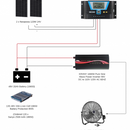Building a Solar Generator Battery Storage System
Hi All – I’m getting started building a battery to set up a solar system to quite simply run a large box fan!
There seems to be a million guides on how to build the battery itself, how to weld it, how to orient the batteries in a series, and what BMS to use and how to wire it. I can’t be sure which one of these guides gives safe advice.
I’m looking to create a ~1kWh, 48V battery from 18650 battery cells that can be charged by solar panels at 48V and power a 140W box fan.
1. Is there a good guide to follow to SAFELY piece together the battery itself? What about wiring?
2. Will the BMS selected function properly for the battery cells and my application?
3. Does my diagram or parts list raise any red flags?
Parts List:
l 120 x Sanyo 2500mah 18650 Cells in Modem Batteries – BP-LC2600/31
l Solar Panel – 2 x Newpowa 120W 24V Monocrystalline Solar Panel
l Controller – PowMr Solar Controller 60A, 12V 24V 36V 48V Auto Dual USB Output Charge Controller
l Inverter – KRXNY 1000W Pure Sine Wave Power Inverter 48V DC to 110V 120V AC 60HZ
l BMS – 13S 48V 20A Li-ion Cell 18650 Battery Protection BMS
Thank you so much!
GBA Detail Library
A collection of one thousand construction details organized by climate and house part










Replies
I built a 2kWh 12v lithium generator along these lines that I have used for the past 4 years.
Suggest you add a fuse between battery and inverter and between CC and battery. Fuses should go as close to the source of power as possible. Blue Sea makes some that bolt right to the battery post. I used 2/0 cable between battery and inverter for 12v. Blue Sea has an on-line calculator which will tell you the correct wire size based on voltage, amperage and length of wire (there-and-back). It’s important to get the correct crimping tools to terminate the wires otherwise you can have a high-resistance connection that can cause a fire (I’ve seen it happen).
I bought a battery with an integrated BMS and Bluetooth.
Forgot to mention, I also added am MC4 in-line fuse after the solar panels. (Not sure what connectors your panels have on them however.)
I like fuses and more fuses is always safer but they need to serve a purpose if the wires between the panel and controller were damaged and shorted it seems unlikely the panels would provide enough wattage to get the wires hot enough to start a fire. However any wire connected to the battery will easily draw power from the battery and start a fire.
Building a big battery is a very dangerous game.
This video shows how not to do it. NO cooling, NO charge controller, no temperature monitoring, and NO fuses. Part of me thinks they intended to have a fire just for YouTube content.
https://www.youtube.com/watch?v=WdDi1haA71Q&t=8s
https://www.youtube.com/watch?v=of01p0Q-yUM&t=17s
Understand when packed tightly together if any one cell fails all the adjoining cells are almost certain to fail. Note the smoke from this fire is toxic.
If you are determined to build your own I recommend you do some destructive testing outdoors 20 feet from anything flammable. Put 6 cells in series and short them out this will help you understand how much energy is stored in the tiny cells.
If the real goal is to move air you chosen fan a 120 volt inefficient induction motor seems like a mistake. Something like this 12 volt radiator fan will move much more air per watt.
https://www.americanvolt.com/products/17-inch-electric-12-volt-engine-radiator-cooling-fan-3000-cfm-slim-reversible?variant=31085152469051¤cy=USD&utm_medium=product_sync&utm_source=google&utm_content=sag_organic&utm_campaign=sag_organic&cmp_id=1686409168&adg_id=65332522066&kwd=&device=c&gclid=Cj0KCQjwwY-LBhD6ARIsACvT72M6zElIoG8XcYYrUrFWzVDj0Z-F-f34JxypHHWo9jVUkOV3ac6h8jcaAvjoEALw_wcB
Walta
In 2021 I would say No to a DIY lithium ion setup.
LiFEPO4 is safer and there are plenty of pre-packaged batteries you can purchase. (I purchased one from AmpereTime on Amazon. )
Is there a reason you like 48 V? (thinner wires)? I think going 12 V and using 12 V automotive fans is much easier. You could still go 24 V to the charger if you desire.
Hopefully this is a real post and not more Newpowa spam...
I would NOT NOT NOT try to assemble your own battery pack here. There is plenty of ways to cause big problems doing this, especially if you aren't experienced with this kind of thing and make a mistake. ONE cell installed backwards can light off all the rest of them and you'll end up with fireworks. Just buy a proper battery pack and be done with it. Lots of people like the Bioenno Power packs, so I'd start there. I would absolutely include a fuse in the wiring though, ideally between both the solar panels and the controller and between the controller/inverter and the load. Use fuses to split the system up so that a failure in one part can't damage any of the other parts. Fuses are cheap, all the rest of the system not so much...
BTW, this isn't really a "generator", it's a solar power supply. I've never liked calling solar stuff "generators", since generators are typically mechanical machines.
Bill